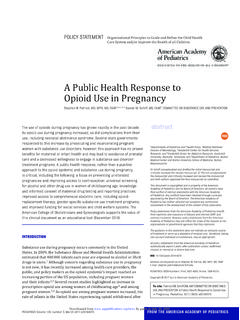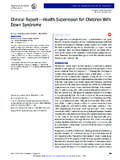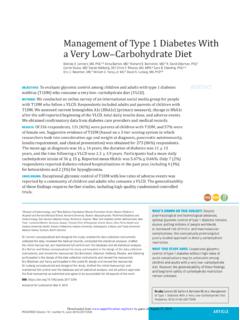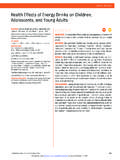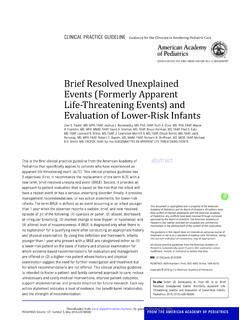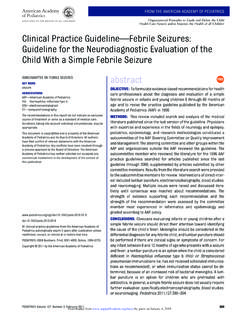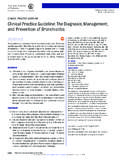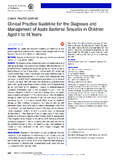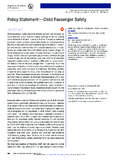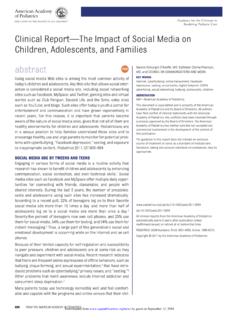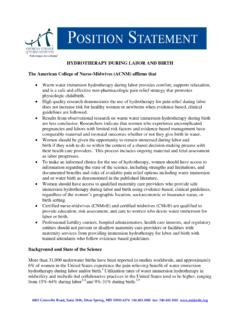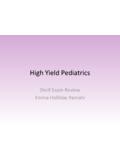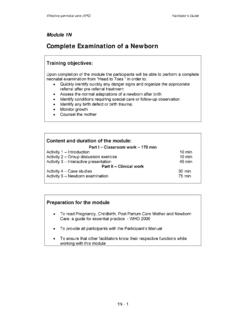Transcription of CLINICALREPORT Safe Transportation of Preterm and Low ...
1 CLINICAL REPORTSafe Transportation of Preterm andLow birth weight Infants atHospital DischargeMarilyn J. Bull, MD, William A. Engle, MD, the Committee on Injury, Violence, and PoisonPrevention and the Committee on Fetus and NewbornABSTRACTSafe Transportation of Preterm and low birth weight infants requires specialconsiderations. Both physiologic immaturity and low birth weight must be takeninto account to properly position such infants. This clinical report provides guide-lines for pediatricians and other caregivers who counsel parents of Preterm andlow birth weight infants about car safety ;123:1424 1429 INTRODUCTIONI mprovedsurvival rates and earlier discharge of Preterm ( 37 weeks gestation atbirth) and low birth weight ( 2500 g at birth ) infants have increased the number ofsmall infants who are being transported in private vehicles.
2 Car safety seats that areused correctly are 71% effective in preventing fatalities attributable to passenger carcrashes in ensure that Preterm and low birth weight infants are trans-ported safely, the proper selection and use of car safety seats or car beds are Motor Vehicle Safety Standard (FMVSS) 213, which establishes designand dynamic performance requirements for child-restraint systems, applies tochildren weighing up to 65 lb. However, the standard has no minimum weightlimit and does not address the relative hypotonia and risk of airway obstruction inpreterm or low birth weight infants. Most rear-facing car safety seats are desig-nated by the manufacturer for use by infants weighing more than 4 or 5 lb, withsome designated for use from birth regardless of as small as lb have been shown to be satisfactorily restrainedin standard rear-facing car safety seats during crash ,3 Test dummies, however,cannot replicate the airway and tone variables that occur in Preterm infants, and thereis no information on restraint of infants who weigh less than lb ( kg).
3 Rear-facing car safety seats provide the best protection in a frontal crash,because the forces are transferred from the back of the restraint to the infant sback, the strongest part of an infant s body. The restraint also supports the infant shead. Severe tensile forces on the neck in flexion are also prevented by use ofrear-facing car safety long-term experience and documented protective value of car safety seatsmake them the preferred choice for travel for all infants who can maintaincardiorespiratory stability in the semireclined car bed that meets FMVSS 213 may be indicated for infantswho manifest apnea, bradycardia, or low oxygen saturation when positioned semireclined in a car safety ,5 Ofnote, some Preterm and term infants positioned in car beds and car safety seats seem to have similar rates of apnea,bradycardia, and oxygen.
4 7A car bed is designed to accommodate an infant in a fully reclined position and is oriented in the vehicle seatperpendicular to the direction of travel. An infant is secured in the car bed with an internal harness, and the car bed issecured to the vehicle with the vehicle s seat belt. Car beds, like car safety seats, have specific weight requirementsdesignated by the manufacturer and, like car safety seats, should be used according to manufacturer size of the infant , especially for those born Preterm , is an important consideration when selecting a car safetyseat or car ,8 weight , length, neurologic maturation, and associated medical conditions (especially bronchopul-monary dysplasia) all influence the potential risk of respiratory compromise for infants in seating ,9 Preterm infants are subject to an increased risk of oxygen desaturation, apnea, and/or bradycardia,10especiallywhen placed in a semireclined position in car ,11 13 Furthermore, frequent cardiorespiratory events clinical reports from the AmericanAcademy of Pediatrics automatically expire5 years after publication unless reaffirmed,revised, or retired at or before that guidance in this report does notindicate an exclusive course of treatmentor serve as a standard of medical , taking into account individualcircumstances, may be document is copyrighted and isproperty of the American Academy ofPediatrics and its Board of Directors.
5 Allauthors have filed conflict-of-intereststatements with the American Academy ofPediatrics. Any conflicts have beenresolved through a process approved bythe Board of Directors. The AmericanAcademy of Pediatrics has neither solicitednor accepted any commercial involvementin the development of the content of Wordssafe Transportation , Preterm , premature,low birth weight , car safety seats, car bedsAbbreviationFMVSS Federal Motor Vehicle SafetyStandardPEDIATRICS (ISSN Numbers: Print, 0031-4005;Online, 1098-4275). Copyright 2009 by theAmerican Academy of Pediatrics1424 AMERICAN ACADEMY OF PEDIATRICSG uidance for the Clinician in RenderingPediatric Care by guest on December 10, from intermittent hypoxia may adversely affect later neuro-development, psychosocial behavior, and ,15In 1 study, mental development in pre-term infants with 5 or more cardiorespiratory eventsduring 210 hours or more of cardiorespiratory monitor-ing was associated with a lower mental developmentindex on the Bayley Scales of infant Development ( ;P.)
6 04)14; physical developmental indiceswere not different ( vs ;P .37). It is unclearwhether the association of cardiorespiratory events andlower mental development reflects an underlying abnor-mality or a negative consequence of the events. It isrational, if practical, to attempt to reduce the frequencyand severity of cardiorespiratory events experienced bypreterm infants seated in car safety seats to minimizepotential neurodevelopmental sequelae. Therefore, carsafety seat monitoring in the infant s own car safety seatbefore discharge from the hospital should be consideredfor all infants less than 37 weeks gestation at birth todetermine if physiologic maturity and stable cardiorespi-ratory function are present, as recommended in theAmerican Academy of Pediatrics publicationGuidelinesfor Perinatal information is limited aboutthe severity and frequency of adverse outcomes in pre-term infants who experience cardiorespiratory events,including those events that occur while in car safetyseats, additional research is are discharged from the hospital withcardiac/apnea monitors, supplemental oxygen, and, occa-sionally, portable ventilators.
7 Suction machines, batteries,and other equipment. These objects are heavy and couldcause injury if they were to hit the child or another ve-hicle occupant in the event of a sudden stop or there is no commercially available securementsystem for portable medical equipment, restraint is data are available to establish a specific age orneurodevelopmental status at which an infant with re-spiratory compromise who was discharged from the hos-pital in a car bed can safely transition to a semireclinedcar safety seat. Before discontinuing use of a car bed, thephysician can consider arranging for a follow-up study todetermine when the infant can travel semireclined with-out apnea, bradycardia, or oxygen desaturation. Thetime to perform the test may vary depending on the rateof growth and neurologic maturation of the infant andthe infant s respiratory status and should be determinedby the treating safety seats are used frequently for positioninginfants for purposes other than travel.
8 Potential detri-mental effects of excessive use of infant seating devices,including exacerbation of gastroesophageal reflux andpotentiation of plagiocephaly, have been ,20 Use of car safety seats for purposes other than travel alsomay increase the risk of adverse cardiorespiratory andother adverse medical IMPLICATIONSS everal important considerations for Transportation of pre-term and low birth weight infants at risk for recurrentoxygen desaturation, apnea, or bradycardia include The increased frequency of oxygen desaturation andepisodes of apnea or bradycardia while sitting in carsafety seats suggests that Preterm infants shouldhave a period of observation in a car safety seat,preferably their own, before hospital discharge .
9 Thisperiod of observation should be performed with theinfant carefully positioned for optimal restraint andthe car safety seat placed at an angle that is approvedfor use in the vehicle. A period of observation for aminimum of 90 to 120 minutes or the duration oftravel, whichever is longer, is ,6,11,212. hospital staff who are trained in positioning infantsproperly in the car safety seat and in detecting ap-nea, bradycardia, and oxygen desaturation shouldconduct the car safety seat Hospitals should develop protocols to include carsafety seat observation before discharge for infantsborn at less than 37 weeks hos-pital protocols include car safety seat observationsfor infants at risk of obstructive apnea, bradycardia,or oxygen desaturation other than those born at lessthan 37 weeks gestation.
10 Examples include infantswith hypotonia (eg, Down syndrome or congenitalneuromuscular disorders), infants with microgna-thia (Pierre Robin sequence), and infants who haveundergone congenital heart Families should be taught by trained hospital staffhow to position the infant properly in the car The duration of time the infant is seated in a carsafety seat should be minimized. Parents should beadvised that car safety seats should be used only A conventional car safety seat that allows for properpositioning of the Preterm infant should be selectedif a semiupright position can be maintained safely bythe infant . Better observation of the infant may bepossible when the child is in a rear-facing car safetyseat adjacent to an adult rather than in a car bed.
